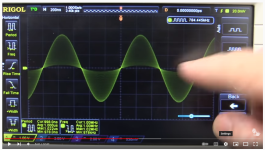What kind of DSO was this? I haven't used a DSO in the last 25 years with a timebase that couldn't run "free". Just put the timebase in "Auto" mode and wind the trigger-level cursor off the screen. And I'd like to see an analog 'scope with a usable "roll" mode. Being a bit of an anlogue enthusiast, I have about 20 oscilloscopes and still resort to the analog occasionally, often because my 200 MHz / 2GSa/s Rigol DS1202CA can't match the bandwidth of my Tek 7904A.
The Rigol is over a decade old now and it has a pathetic memory depth which means it can't do things like properly display an AM or SSB modulation envelope, so nearly any of my analogue 'scopes with at least 20 MHz bandwidth are better for that task. However, all but the crappiest low-end DSOs these days have plenty of memory depth, allowing them to maintain high sampling rates at low timebase settings, so
aliasing really isn't much of a thing with DSOs anymore. Oh, and the "digital phosphor" concept (trademarked by Tektronix and copied by nearly everyone else) of trace intensity modulation has got be be nigh on two decades old now. It was a bit crap back around about the year 2003 or 2004 when I first got the opportunity to asses a DSO with the capability, but things have come a long way since then, even for the budget machines. Skip to 6m 30s in the video here:
View attachment 1242581
But this is a vintage computer hardware forum, not a HAM radio forum. While nearly any old analog 'scope is better than no 'scope at all, when it comes to digital stuff, the single-shot timebase and storage capabilities of a DSO, even one as old as my Rigol DS1202CA, renders an old analog clunker next to useless in comparison.



